
ai-goat
Learn AI security through a series of vulnerable LLM CTF challenges. No sign ups, no cloud fees, run everything locally on your system.
Stars: 105
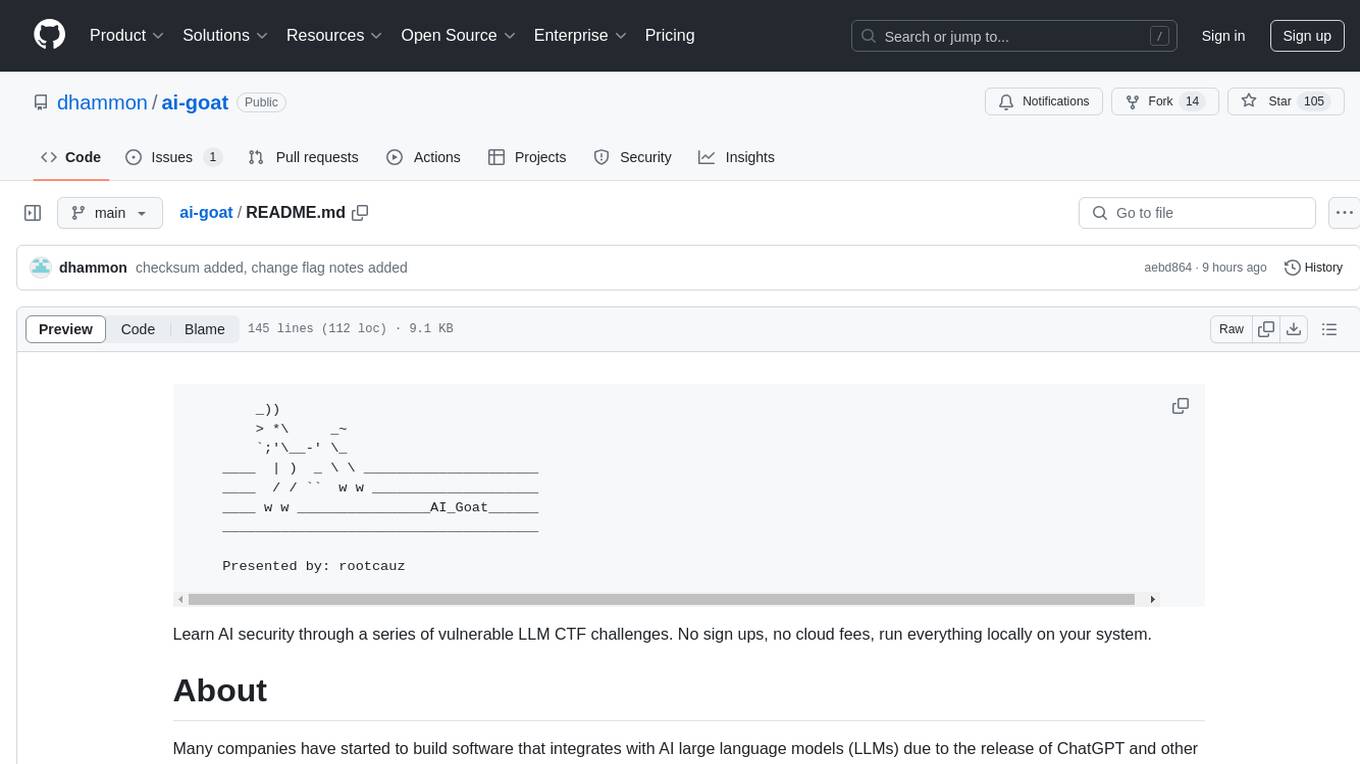
AI Goat is a tool designed to help users learn about AI security through a series of vulnerable LLM CTF challenges. It allows users to run everything locally on their system without the need for sign-ups or cloud fees. The tool focuses on exploring security risks associated with large language models (LLMs) like ChatGPT, providing practical experience for security researchers to understand vulnerabilities and exploitation techniques. AI Goat uses the Vicuna LLM, derived from Meta's LLaMA and ChatGPT's response data, to create challenges that involve prompt injections, insecure output handling, and other LLM security threats. The tool also includes a prebuilt Docker image, ai-base, containing all necessary libraries to run the LLM and challenges, along with an optional CTFd container for challenge management and flag submission.
README:
_))
> *\ _~
`;'\__-' \_
____ | ) _ \ \ _____________________
____ / / `` w w ____________________
____ w w ________________AI_Goat______
______________________________________
Presented by: rootcauz
Learn AI security through a series of vulnerable LLM CTF challenges. No sign ups, no cloud fees, run everything locally on your system.
Many companies have started to build software that integrates with AI large language models (LLMs) due to the release of ChatGPT and other engines. This explosion of interest has led to the rapid development systems that reintroduce old vulnerabilities and impose new classes of less understood threats. Many company security teams may not be fully equipped do deal with LLM security as the field is still maturing with tools and learning resources.
I've developed AI Goat to learn about LLM development and the security risks companies face that use it. The CTF format is a great way for security researchers to gain practical experience and learn about how these systems are vulnerable and can be exploited. Thank you for your interest in this project and I hope you have fun!
The OWASP Top 10 for LLM Applications is a great place to start learning about LLM security threats and mitigations. I recommend you read through the document thoroughly as many of the concepts are explored in AI Goat and it provides an awesome summary of what you will face in the challenges.
Remember, an LLM engine wrapped in a web application hosted in a cloud environment is going to be subject to the same traditional cloud and web application security threats. In addition to these traditional threats, LLM projects will also be subject to the following noncomprehensive list of threats:
- Prompt Injection
- Insecure Output Handling
- Training Data Poisoning
- Denial of Service
- Supply Chain
- Permission Issues
- Data Leakage
- Excessive Agency
- Overreliance
- Insecure Plugins
AI Goat uses the Vicuna LLM which derived from Meta's LLaMA and coupled with ChatGPT's response data. When installing AI Goat the LLM binary is downloaded from HuggingFace locally on your computer. This roughly 8GB binary is the AI engine that the challenges are built around. The LLM binary essentially takes an input "prompt" and gives an output, "response". The prompt consists of three elements concatenated together in a string. These elements are: 1. Instructions; 2. Question; and 3. Response. The Instructions element consists of the described rules for the LLM. They are meant to describe to the LLM how it is supposed to behave. The Question element is where most systems allow user input. For instance, the comment entered into a chat engine would be placed in the Question element. Lastly, the Response section prescribes that the LLM give a response to the question.
A prebuilt Docker image, ai-base, has all the libraries needed to run the LLM and challenges. This container is downloaded during the installation process along with the LLM binary. A docker compose that launches each challenge attaches the LLM binary, specific challenge files, and exposes TCP ports needed to complete each challenge. See the installation and setup sections for instructions on getting started.
An optional CTFd container has been prepared that includes each challenge description, hints, category, and flag submission. The container image is hosted in our dockerhub and is call ai-ctfd alongside the ai-base image. The ai-ctfd container can be launched from the ai-goat.py and accessed using your browser.
- git
sudo apt install git -y
- python3
- pip3
sudo apt install python3-pip -y
- Docker
- docker-compose
- User in docker group
sudo usermod -aG docker $USERreboot
- 8GBs of drive space
- Minimum 16GB system memory with at least 8GB dedicated to the challenge; otherwise LLM responses take too long
- A love for cybersecurity!
git clone https://github.com/dhammon/ai-goat
cd ai-goat
pip3 install -r requirements.txt
chmod +x ai-goat.py
./ai-goat.py --install
This section expects that you have already followed the Installation steps.
Using ai-ctfd provides you with a listing of all the challenges and flag submission. It is a great tool to use by yourself or when hosting a CTF. Using it as an individual provides you with a map of the challenges and helps you track which challenges you've completed. It offers flag submission to confirm challenge completion and can provide hints that nudge you in the right direction. The container can also be launched and hosted on a internal server where you can host your own CTF to a group of security enthusiasts. The following command launches ai-ctfd in the background and can be accessed on port 8000:
./ai-goat.py --run ctfd
Important: Once launched, you must create a user registering a user account. This registration stays local on the container and does not require a real email address.
You can change the flags within the challenges source code and then in CTFD (they must match).
- After you clone the repo, navigate to
ai-goat/app/challenges/1/app.pyand change the flag in the string on line 12. - Then navigate to
ai-goat/app/challenges/2/entrypoint.shand change the flag on line 3. - Next you will need to change the flags in CTFD. Launch CTFD (
./ai-goat.py --run ctfdand open browser tohttp://127.0.0.1:8000) and then login with therootuser usingqVLv27Dsy5WuXRubjfIIas the password. - Once logged in, navigate the admin panel (top nav bar) -> Challenges (top nav bar) -> select a challenge -> and hit the Flags sub-tab.
- Change the flag for each CTFD challenge to match the same string you changed the in the source code.
Have fun!
See the Challenges section for a description of each challenge or refer to the ai-ctfd web page from Step 1. The following command launches the first challenge:
./ai-goat.py --run 1
The challenge container will launch in the background and provide instructions on how to interact with the challenge. Each challenge has a flag, which is a string surrounded by curly braces. For example: {eXampl3F!ag}. You verify the flag through submission to the subject challenge in the ai-ctfd page.
Important: Sometimes LLMs make up the flag value, so make sure you verify the flag in ai-ctfd ;)
Important: The LLM response can take 30 seconds or so
- Challenges can be restarted by rerunning the challenge. Example:
./ai-goat.py --run <CHALLENGE NUMBER>. This command will restart the container if it is already running. - You might inadvertently pollute or break a challenge container. Use docker commands to stop containers if needed. To list containers:
docker container ps. To stop a container:docker stop <CONTAINER NAME>.
The main branch will always contain the latest release. Historical versions will be maintained in respective branches. Upgrade instructions:
cd ai-goat
git pull
pip3 install -r requirements.txt
chmod +x ai-goat.py
./ai-goat.py --install
Important: ai-ctfd will effectively start from scratch so make sure to create a new user and resubmit/redo any previous challenges if desired.
Successful prompt injection attacks influence the LLM to respond with information they are not intended to divulge. In this challenge, an AI chatbot running on port 9001 is storing the flag as a secret and has been prompted to not give it up. Can you convince or trick the bot into giving you the flag?
./ai-goat.py -r 1
LLM01: Prompt Injections | LLM07: Data Leakage
LLM system output shouldn't be trusted, especially when that output is used in downstream operations such as OS commands or network calls. This challenge has another AI chatbot running on port 9002 that takes a user question and returns a website's title. The user input is converted into a URL by the chatbot where it is used to request that site's source while ripping the the title. What else could this chatbot have network access to?
./ai-goat.py -r 2
LLM02: Insecure Output Handling
Latest version is main branch. You can find the version in the CHANGELOG.md file. Branches are created for each respective version.
CTF engine: CTFD
Art by: ejm97 on ascii.co.uk
AI container technology:
- Library: llama-cpp-python
- Large Language Model: Vicuna LLM
For Tasks:
Click tags to check more tools for each tasksFor Jobs:
Alternative AI tools for ai-goat
Similar Open Source Tools

ai-goat
AI Goat is a tool designed to help users learn about AI security through a series of vulnerable LLM CTF challenges. It allows users to run everything locally on their system without the need for sign-ups or cloud fees. The tool focuses on exploring security risks associated with large language models (LLMs) like ChatGPT, providing practical experience for security researchers to understand vulnerabilities and exploitation techniques. AI Goat uses the Vicuna LLM, derived from Meta's LLaMA and ChatGPT's response data, to create challenges that involve prompt injections, insecure output handling, and other LLM security threats. The tool also includes a prebuilt Docker image, ai-base, containing all necessary libraries to run the LLM and challenges, along with an optional CTFd container for challenge management and flag submission.
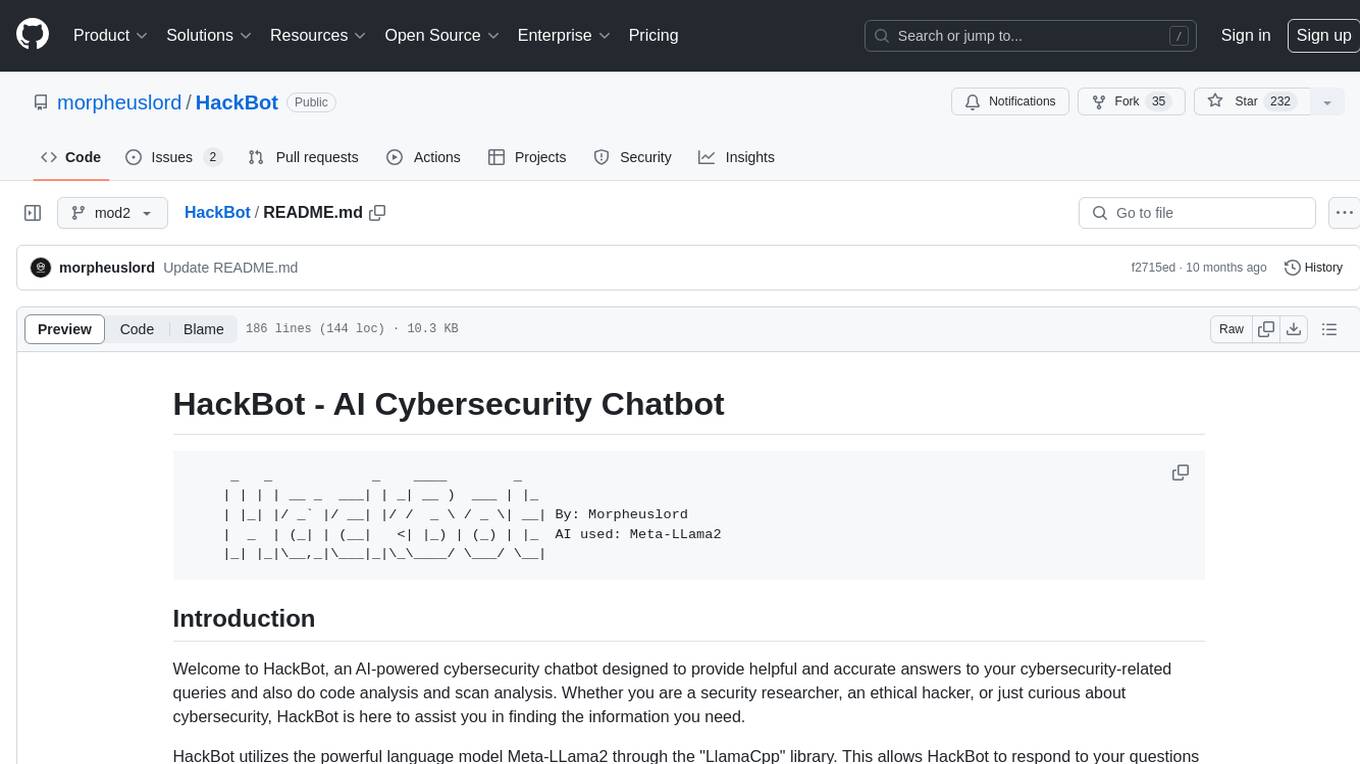
HackBot
HackBot is an AI-powered cybersecurity chatbot designed to provide accurate answers to cybersecurity-related queries, conduct code analysis, and scan analysis. It utilizes the Meta-LLama2 AI model through the 'LlamaCpp' library to respond coherently. The chatbot offers features like local AI/Runpod deployment support, cybersecurity chat assistance, interactive interface, clear output presentation, static code analysis, and vulnerability analysis. Users can interact with HackBot through a command-line interface and utilize it for various cybersecurity tasks.
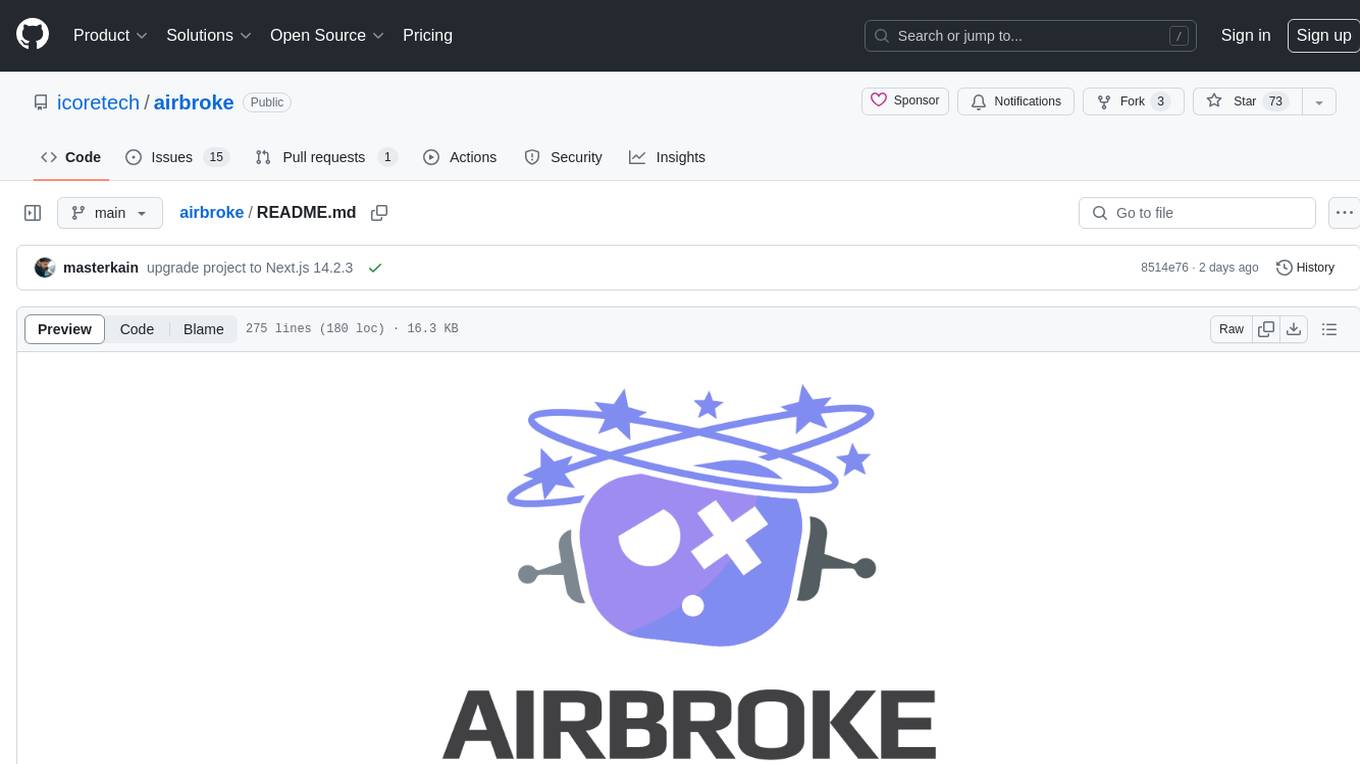
airbroke
Airbroke is an open-source error catcher tool designed for modern web applications. It provides a PostgreSQL-based backend with an Airbrake-compatible HTTP collector endpoint and a React-based frontend for error management. The tool focuses on simplicity, maintaining a small database footprint even under heavy data ingestion. Users can ask AI about issues, replay HTTP exceptions, and save/manage bookmarks for important occurrences. Airbroke supports multiple OAuth providers for secure user authentication and offers occurrence charts for better insights into error occurrences. The tool can be deployed in various ways, including building from source, using Docker images, deploying on Vercel, Render.com, Kubernetes with Helm, or Docker Compose. It requires Node.js, PostgreSQL, and specific system resources for deployment.
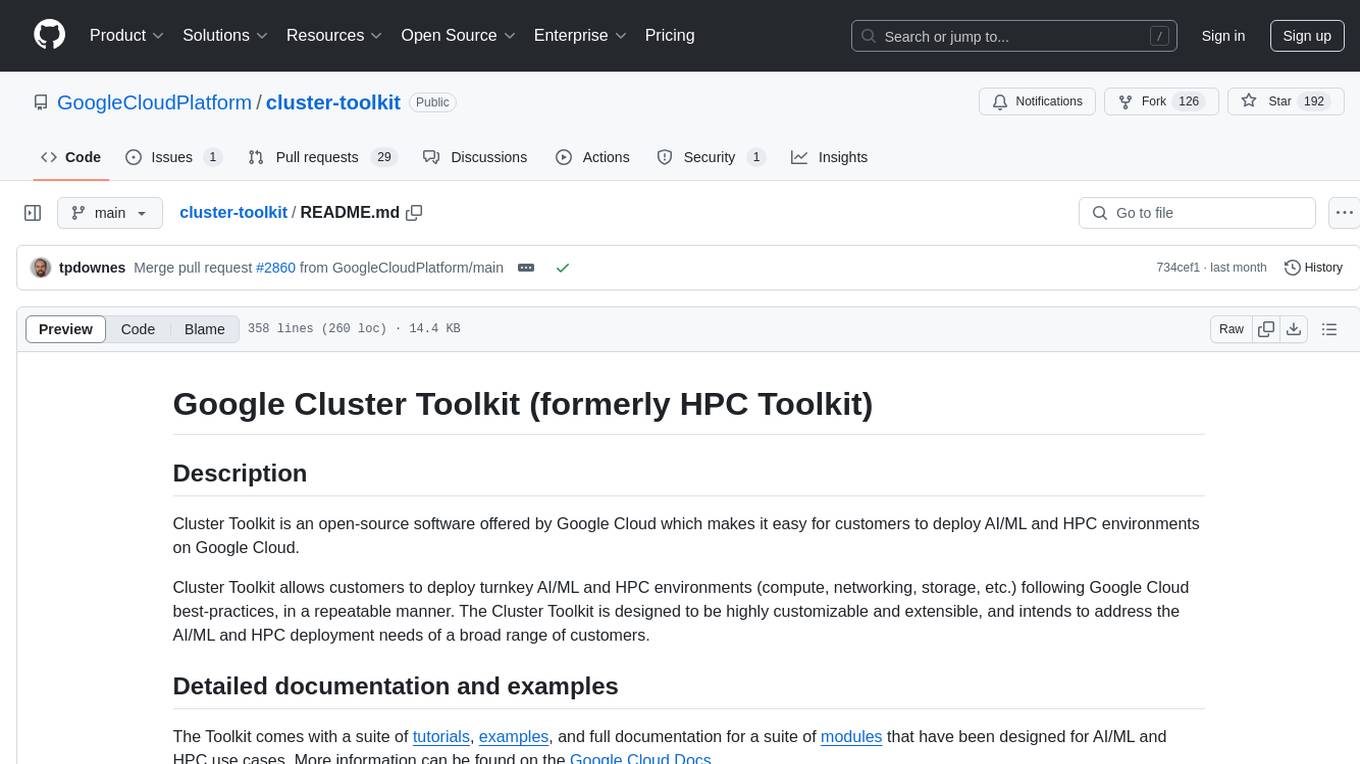
cluster-toolkit
Cluster Toolkit is an open-source software by Google Cloud for deploying AI/ML and HPC environments on Google Cloud. It allows easy deployment following best practices, with high customization and extensibility. The toolkit includes tutorials, examples, and documentation for various modules designed for AI/ML and HPC use cases.
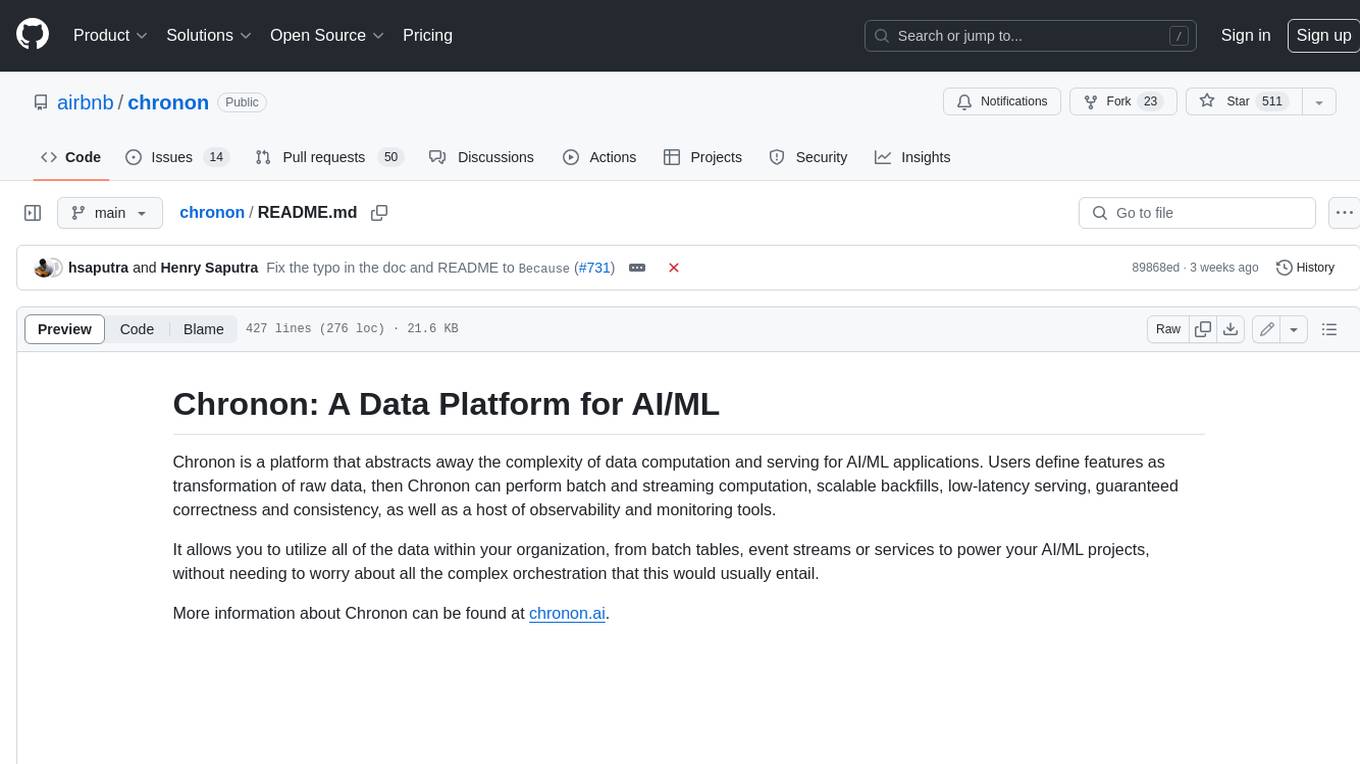
chronon
Chronon is a platform that simplifies and improves ML workflows by providing a central place to define features, ensuring point-in-time correctness for backfills, simplifying orchestration for batch and streaming pipelines, offering easy endpoints for feature fetching, and guaranteeing and measuring consistency. It offers benefits over other approaches by enabling the use of a broad set of data for training, handling large aggregations and other computationally intensive transformations, and abstracting away the infrastructure complexity of data plumbing.
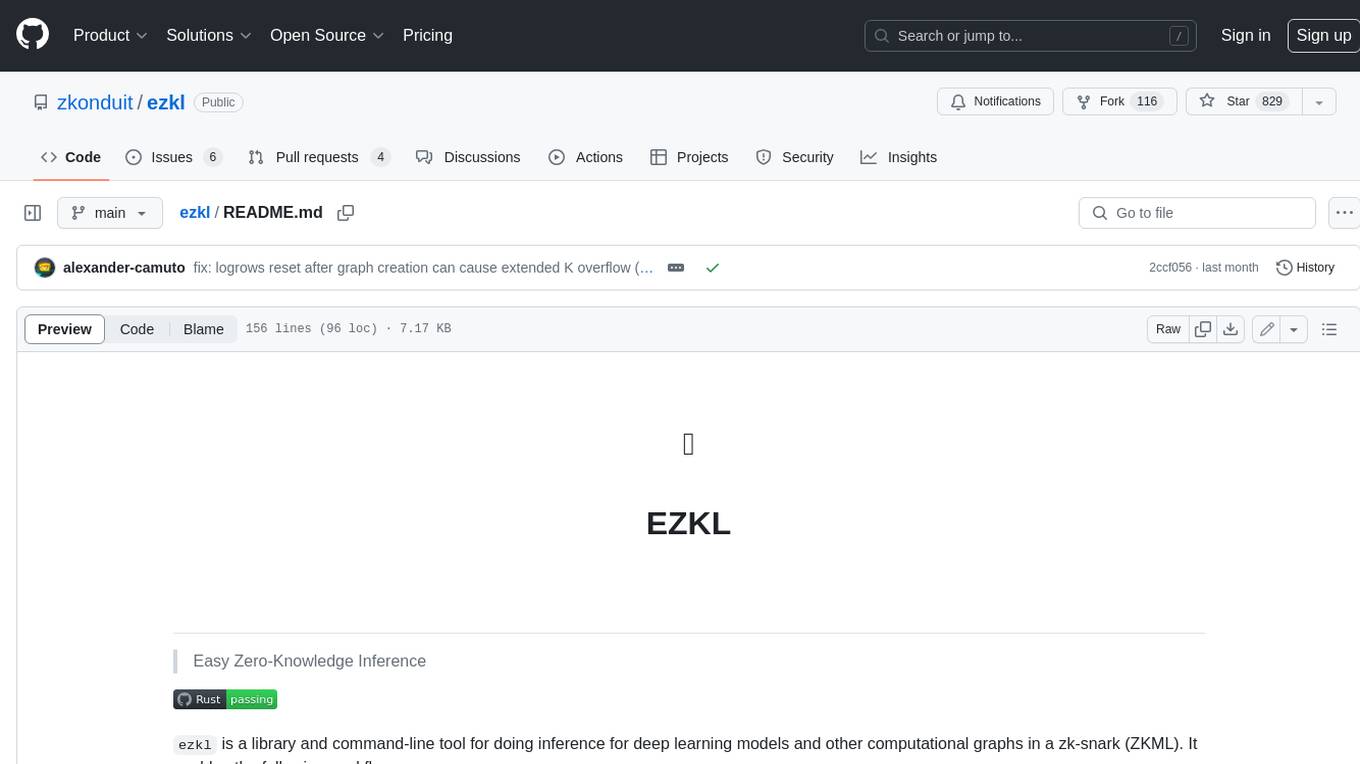
ezkl
EZKL is a library and command-line tool for doing inference for deep learning models and other computational graphs in a zk-snark (ZKML). It enables the following workflow: 1. Define a computational graph, for instance a neural network (but really any arbitrary set of operations), as you would normally in pytorch or tensorflow. 2. Export the final graph of operations as an .onnx file and some sample inputs to a .json file. 3. Point ezkl to the .onnx and .json files to generate a ZK-SNARK circuit with which you can prove statements such as: > "I ran this publicly available neural network on some private data and it produced this output" > "I ran my private neural network on some public data and it produced this output" > "I correctly ran this publicly available neural network on some public data and it produced this output" In the backend we use the collaboratively-developed Halo2 as a proof system. The generated proofs can then be verified with much less computational resources, including on-chain (with the Ethereum Virtual Machine), in a browser, or on a device.
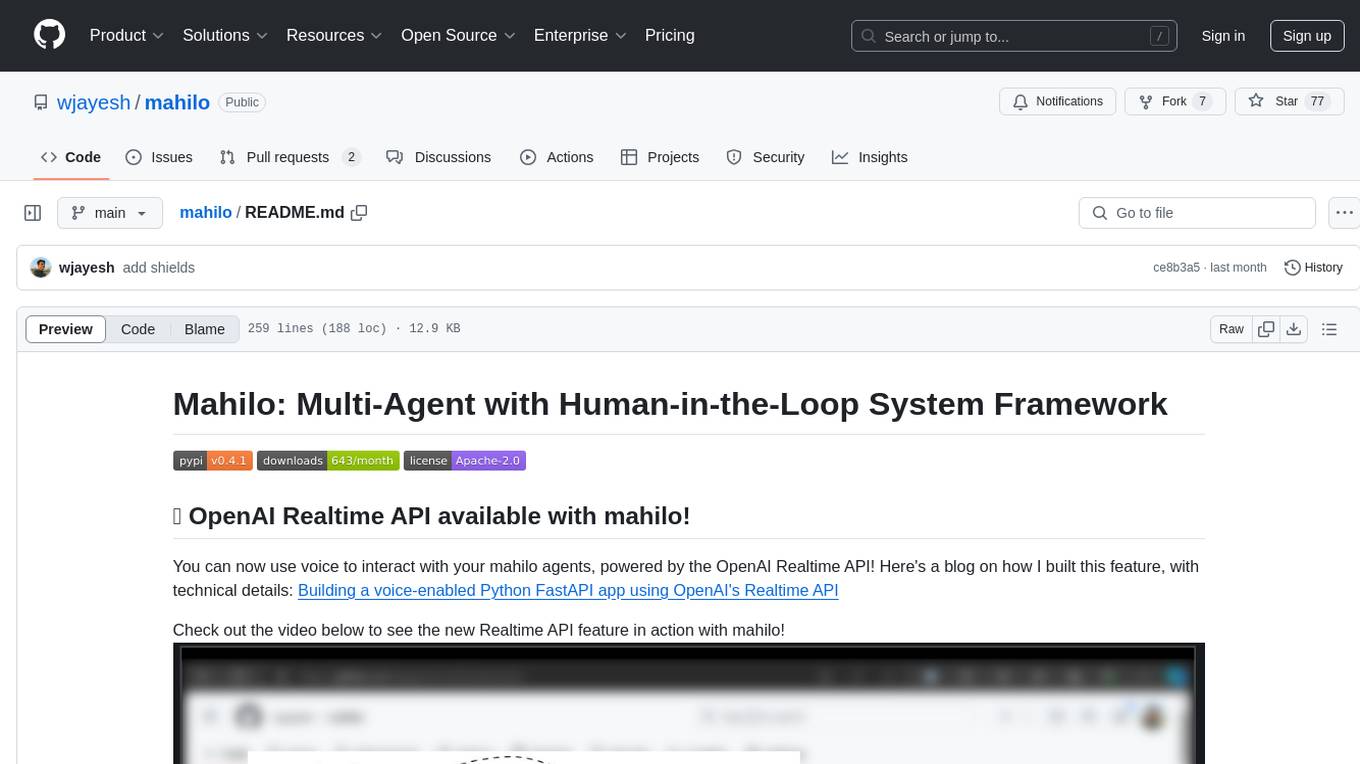
mahilo
Mahilo is a flexible framework for creating multi-agent systems that can interact with humans while sharing context internally. It allows developers to set up complex agent networks for various applications, from customer service to emergency response simulations. Agents can communicate with each other and with humans, making the system efficient by handling context from multiple agents and helping humans stay focused on specific problems. The system supports Realtime API for voice interactions, WebSocket-based communication, flexible communication patterns, session management, and easy agent definition.
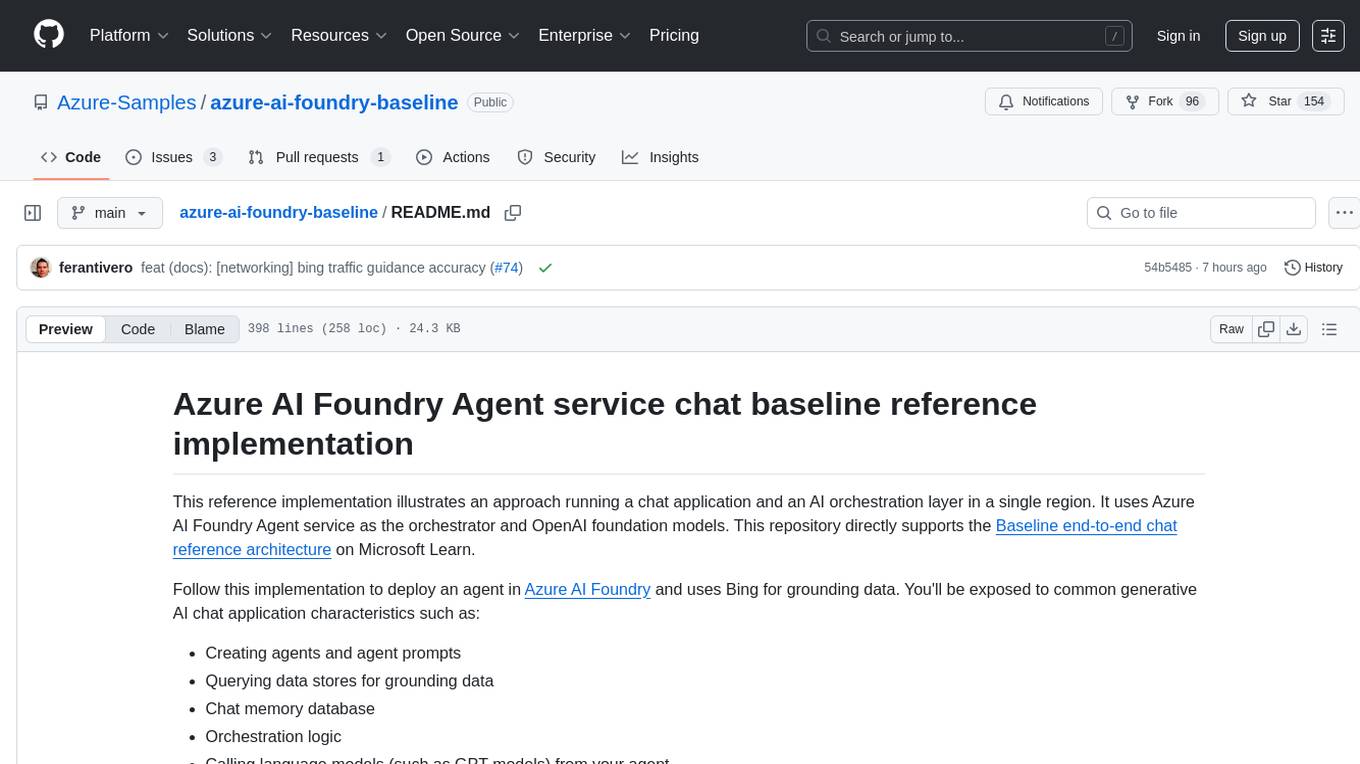
azure-ai-foundry-baseline
This repository serves as a reference implementation for running a chat application and an AI orchestration layer using Azure AI Foundry Agent service and OpenAI foundation models. It covers common generative AI chat application characteristics such as creating agents, querying data stores, chat memory database, orchestration logic, and calling language models. The implementation also includes production requirements like network isolation, Azure AI Foundry Agent Service dependencies, availability zone reliability, and limiting egress network traffic with Azure Firewall.
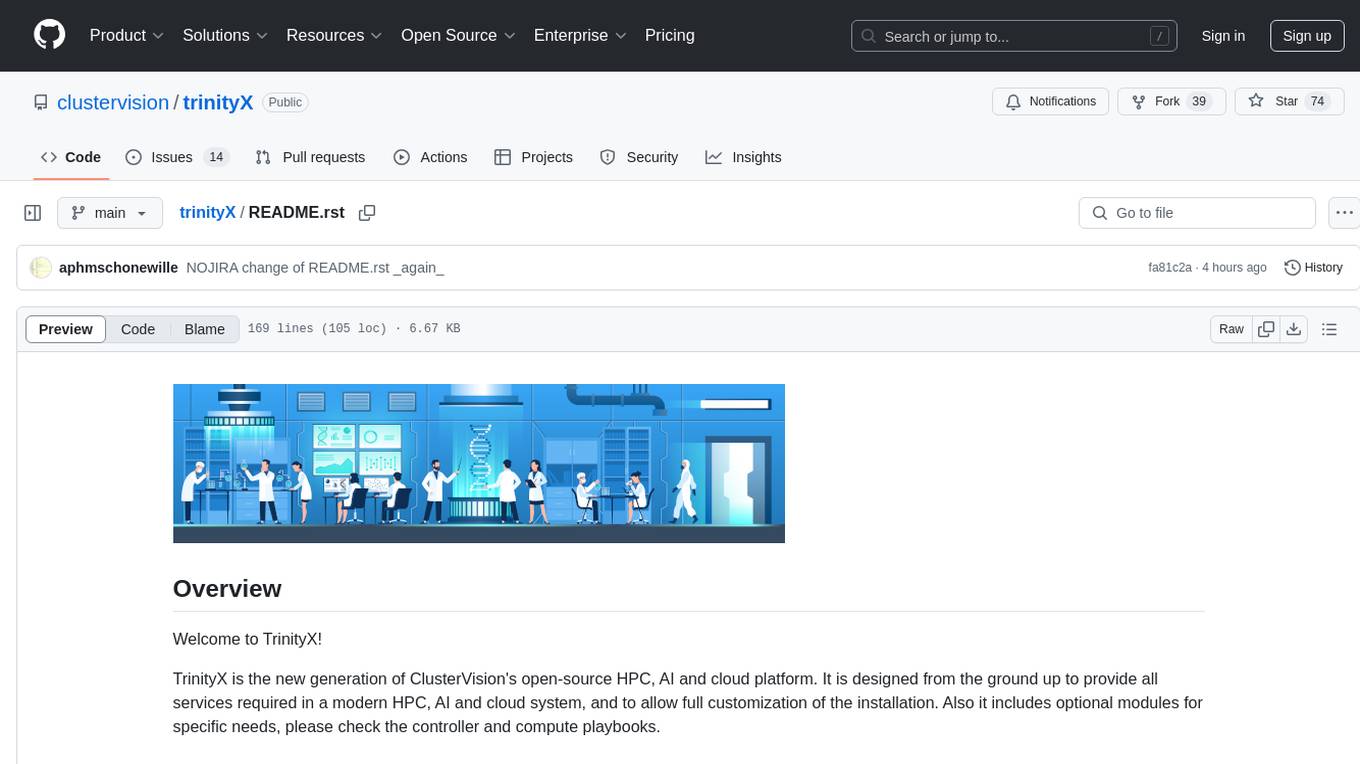
trinityX
TrinityX is an open-source HPC, AI, and cloud platform designed to provide all services required in a modern system, with full customization options. It includes default services like Luna node provisioner, OpenLDAP, SLURM or OpenPBS, Prometheus, Grafana, OpenOndemand, and more. TrinityX also sets up NFS-shared directories, OpenHPC applications, environment modules, HA, and more. Users can install TrinityX on Enterprise Linux, configure network interfaces, set up passwordless authentication, and customize the installation using Ansible playbooks. The platform supports HA, OpenHPC integration, and provides detailed documentation for users to contribute to the project.
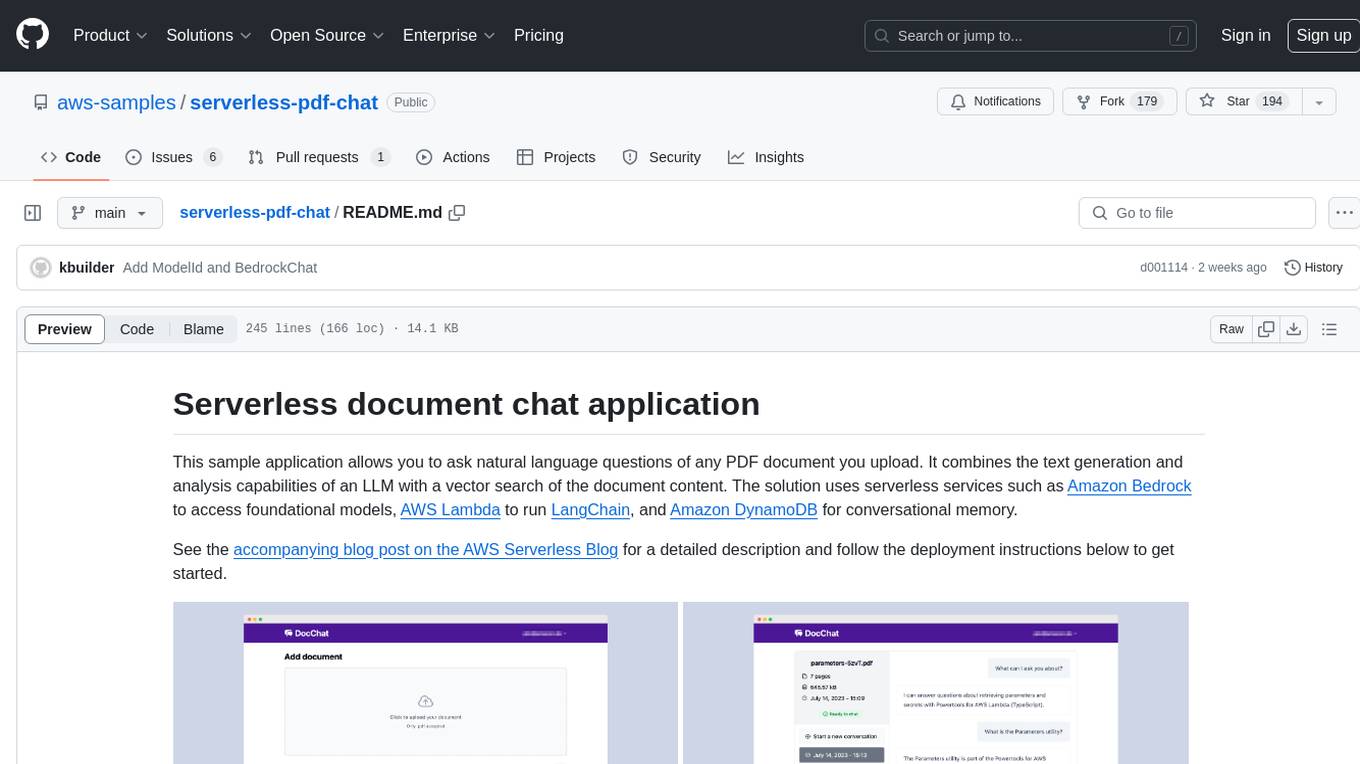
serverless-pdf-chat
The serverless-pdf-chat repository contains a sample application that allows users to ask natural language questions of any PDF document they upload. It leverages serverless services like Amazon Bedrock, AWS Lambda, and Amazon DynamoDB to provide text generation and analysis capabilities. The application architecture involves uploading a PDF document to an S3 bucket, extracting metadata, converting text to vectors, and using a LangChain to search for information related to user prompts. The application is not intended for production use and serves as a demonstration and educational tool.
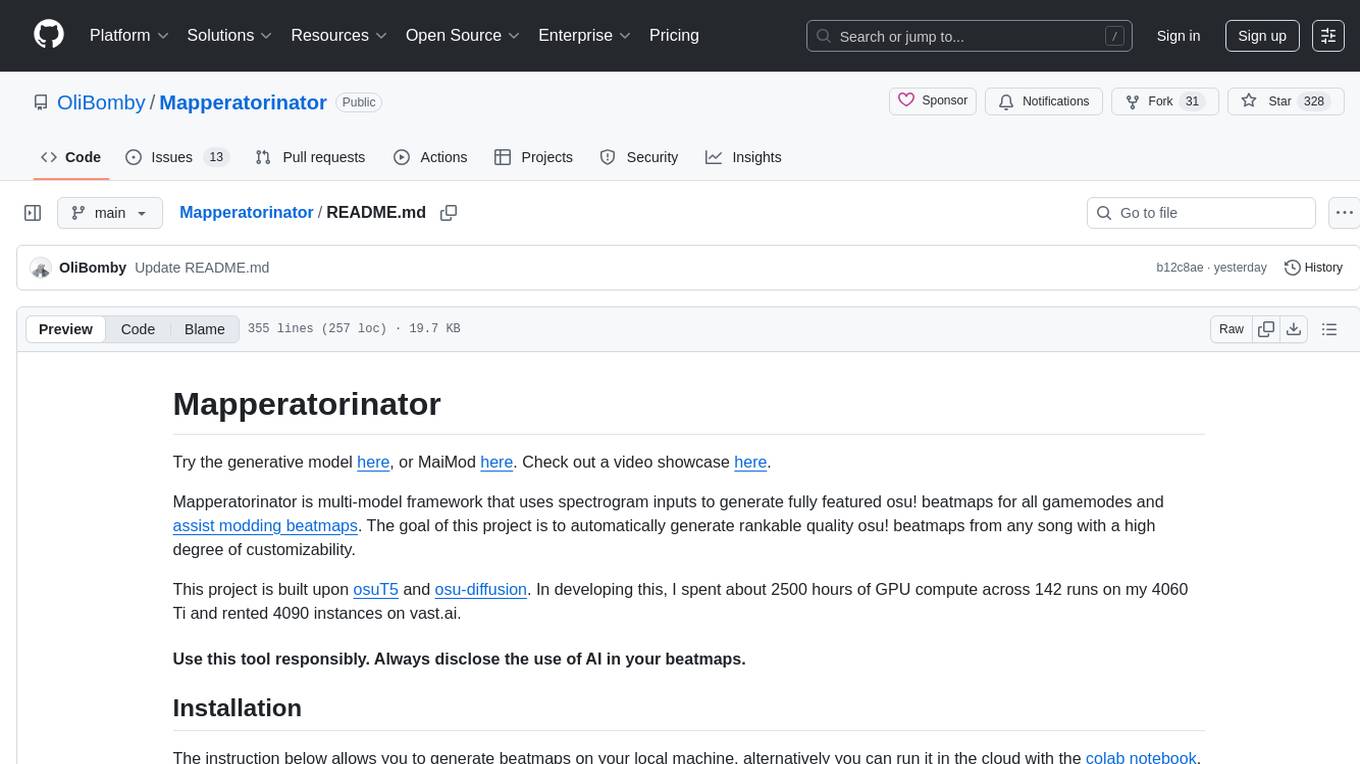
Mapperatorinator
Mapperatorinator is a multi-model framework that uses spectrogram inputs to generate fully featured osu! beatmaps for all gamemodes and assist modding beatmaps. The project aims to automatically generate rankable quality osu! beatmaps from any song with a high degree of customizability. The tool is built upon osuT5 and osu-diffusion, utilizing GPU compute and instances on vast.ai for development. Users can responsibly use AI in their beatmaps with this tool, ensuring disclosure of AI usage. Installation instructions include cloning the repository, creating a virtual environment, and installing dependencies. The tool offers a Web GUI for user-friendly experience and a Command-Line Inference option for advanced configurations. Additionally, an Interactive CLI script is available for terminal-based workflow with guided setup. The tool provides generation tips and features MaiMod, an AI-driven modding tool for osu! beatmaps. Mapperatorinator tokenizes beatmaps, utilizes a model architecture based on HF Transformers Whisper model, and offers multitask training format for conditional generation. The tool ensures seamless long generation, refines coordinates with diffusion, and performs post-processing for improved beatmap quality. Super timing generator enhances timing accuracy, and LoRA fine-tuning allows adaptation to specific styles or gamemodes. The project acknowledges credits and related works in the osu! community.
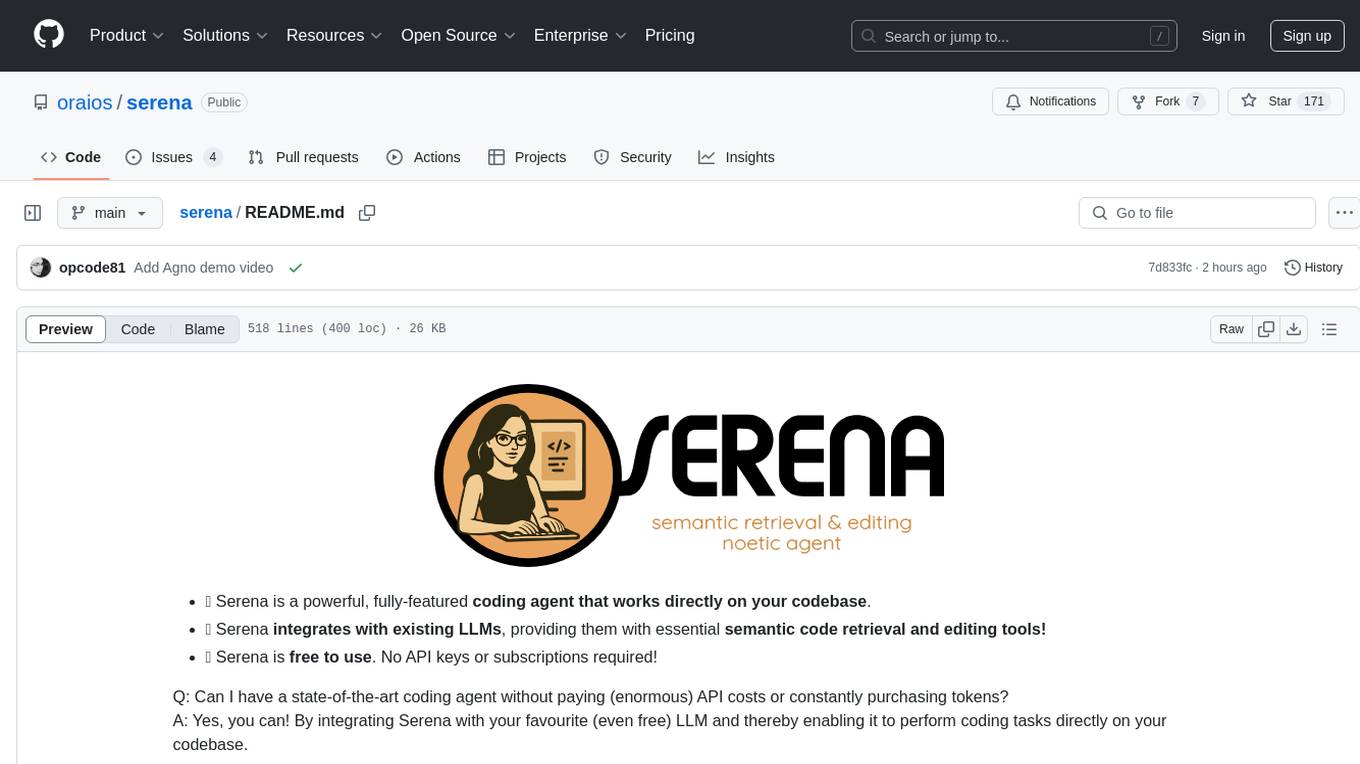
serena
Serena is a powerful coding agent that integrates with existing LLMs to provide essential semantic code retrieval and editing tools. It is free to use and does not require API keys or subscriptions. Serena can be used for coding tasks such as analyzing, planning, and editing code directly on your codebase. It supports various programming languages and offers semantic code analysis capabilities through language servers. Serena can be integrated with different LLMs using the model context protocol (MCP) or Agno framework. The tool provides a range of functionalities for code retrieval, editing, and execution, making it a versatile coding assistant for developers.
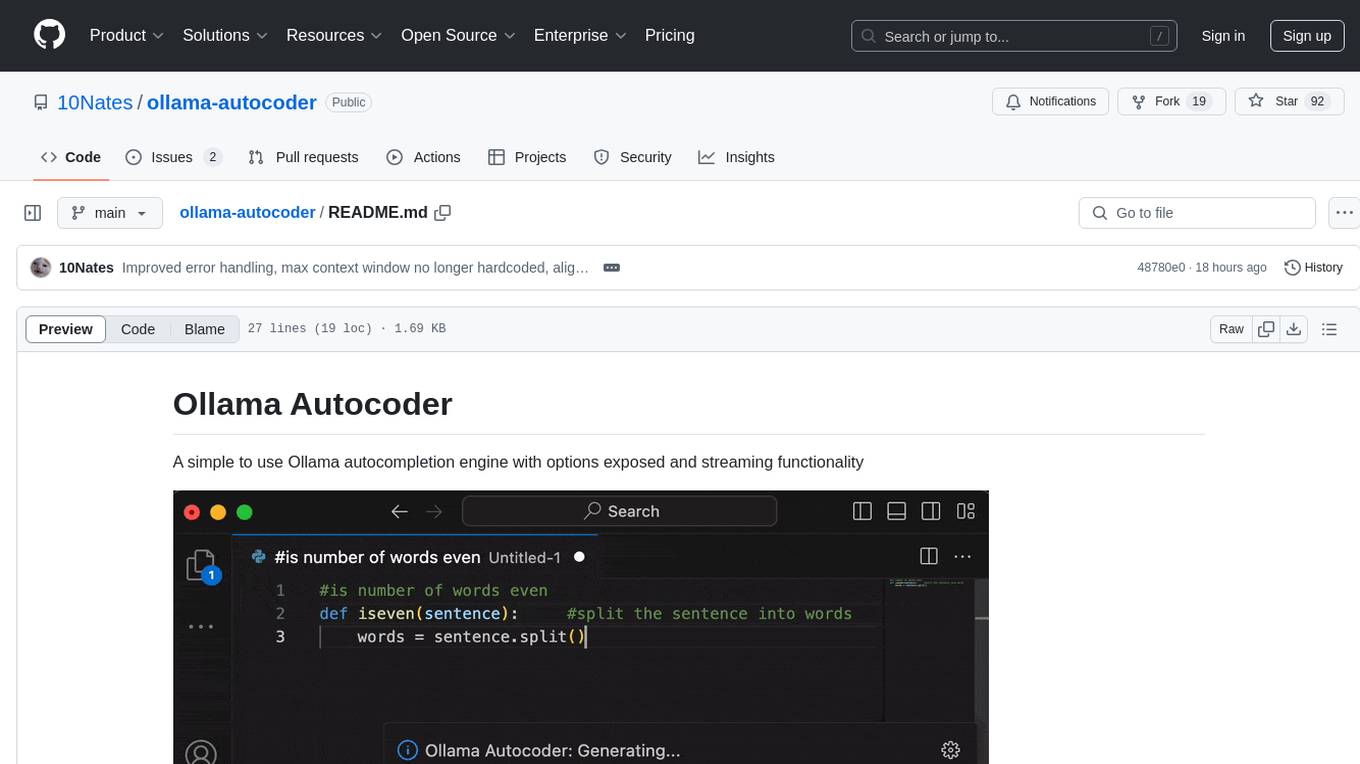
ollama-autocoder
Ollama Autocoder is a simple to use autocompletion engine that integrates with Ollama AI. It provides options for streaming functionality and requires specific settings for optimal performance. Users can easily generate text completions by pressing a key or using a command pallete. The tool is designed to work with Ollama API and a specified model, offering real-time generation of text suggestions.
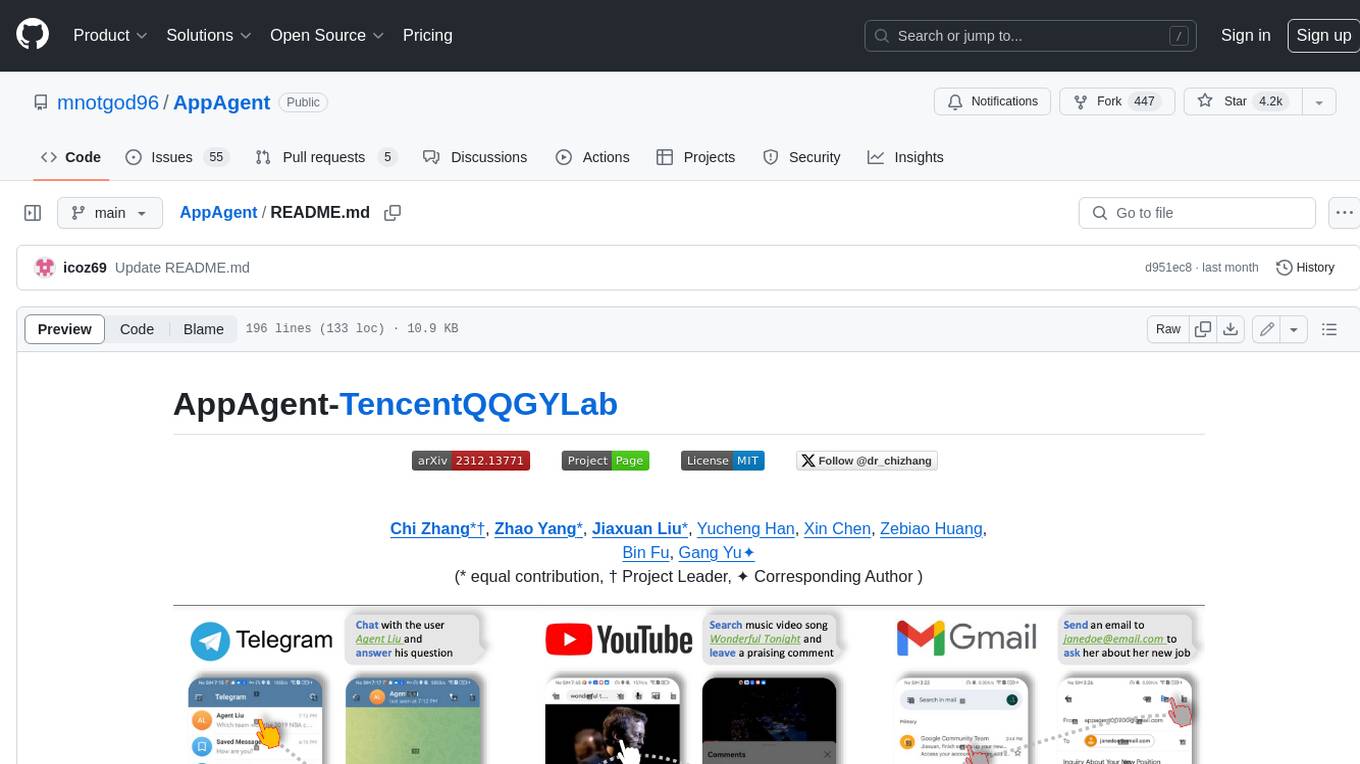
AppAgent
AppAgent is a novel LLM-based multimodal agent framework designed to operate smartphone applications. Our framework enables the agent to operate smartphone applications through a simplified action space, mimicking human-like interactions such as tapping and swiping. This novel approach bypasses the need for system back-end access, thereby broadening its applicability across diverse apps. Central to our agent's functionality is its innovative learning method. The agent learns to navigate and use new apps either through autonomous exploration or by observing human demonstrations. This process generates a knowledge base that the agent refers to for executing complex tasks across different applications.
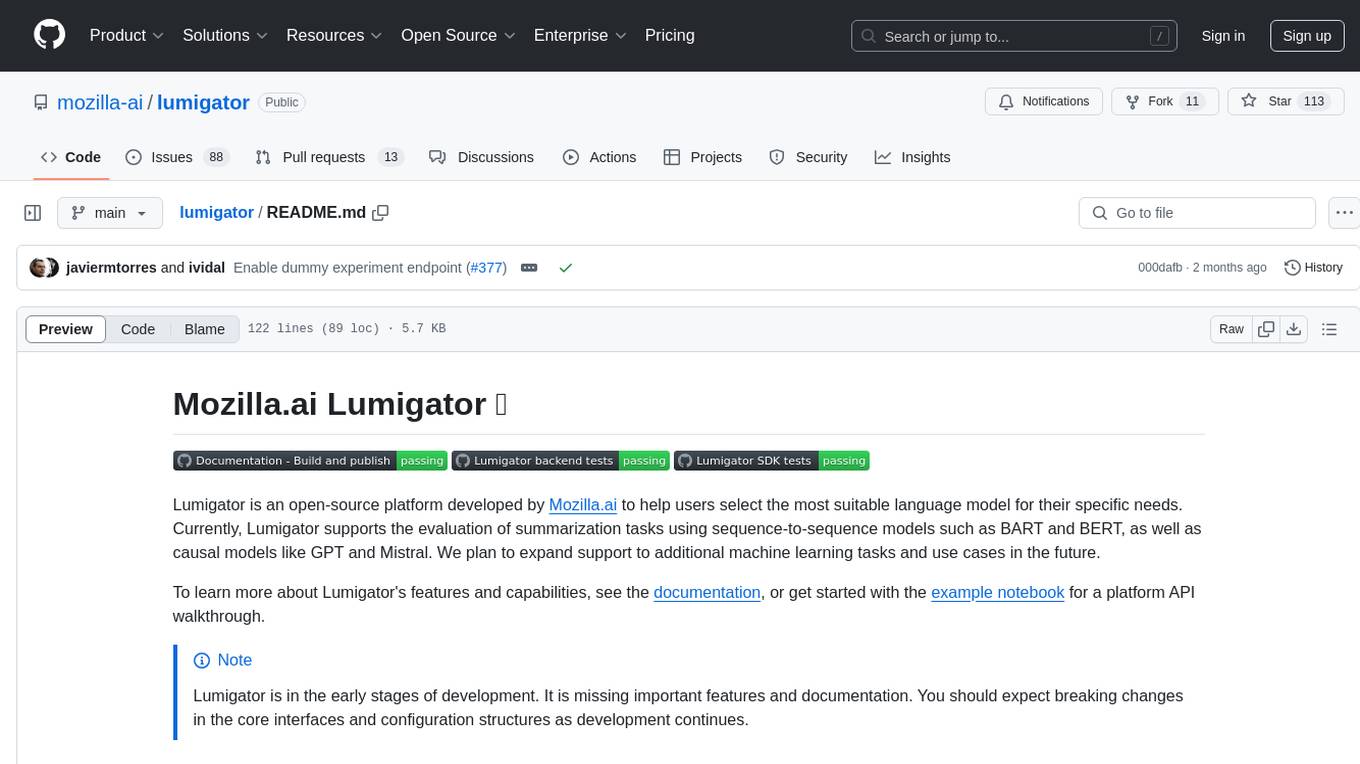
lumigator
Lumigator is an open-source platform developed by Mozilla.ai to help users select the most suitable language model for their specific needs. It supports the evaluation of summarization tasks using sequence-to-sequence models such as BART and BERT, as well as causal models like GPT and Mistral. The platform aims to make model selection transparent, efficient, and empowering by providing a framework for comparing LLMs using task-specific metrics to evaluate how well a model fits a project's needs. Lumigator is in the early stages of development and plans to expand support to additional machine learning tasks and use cases in the future.

airgeddon-plugins
airgeddon-plugins is a collection of plugins for the airgeddon tool, designed to enhance its functionality and address specific issues related to wireless network security. These plugins include features such as performing dictionary online attacks on WPA3 networks, allowing all characters on Captive Portal passwords, and fixing compatibility issues with certain Realtek chipsets. The plugins are designed to be deployed within the airgeddon tool directory, providing additional capabilities and options for users.
For similar tasks

ai-goat
AI Goat is a tool designed to help users learn about AI security through a series of vulnerable LLM CTF challenges. It allows users to run everything locally on their system without the need for sign-ups or cloud fees. The tool focuses on exploring security risks associated with large language models (LLMs) like ChatGPT, providing practical experience for security researchers to understand vulnerabilities and exploitation techniques. AI Goat uses the Vicuna LLM, derived from Meta's LLaMA and ChatGPT's response data, to create challenges that involve prompt injections, insecure output handling, and other LLM security threats. The tool also includes a prebuilt Docker image, ai-base, containing all necessary libraries to run the LLM and challenges, along with an optional CTFd container for challenge management and flag submission.
For similar jobs

ai-goat
AI Goat is a tool designed to help users learn about AI security through a series of vulnerable LLM CTF challenges. It allows users to run everything locally on their system without the need for sign-ups or cloud fees. The tool focuses on exploring security risks associated with large language models (LLMs) like ChatGPT, providing practical experience for security researchers to understand vulnerabilities and exploitation techniques. AI Goat uses the Vicuna LLM, derived from Meta's LLaMA and ChatGPT's response data, to create challenges that involve prompt injections, insecure output handling, and other LLM security threats. The tool also includes a prebuilt Docker image, ai-base, containing all necessary libraries to run the LLM and challenges, along with an optional CTFd container for challenge management and flag submission.
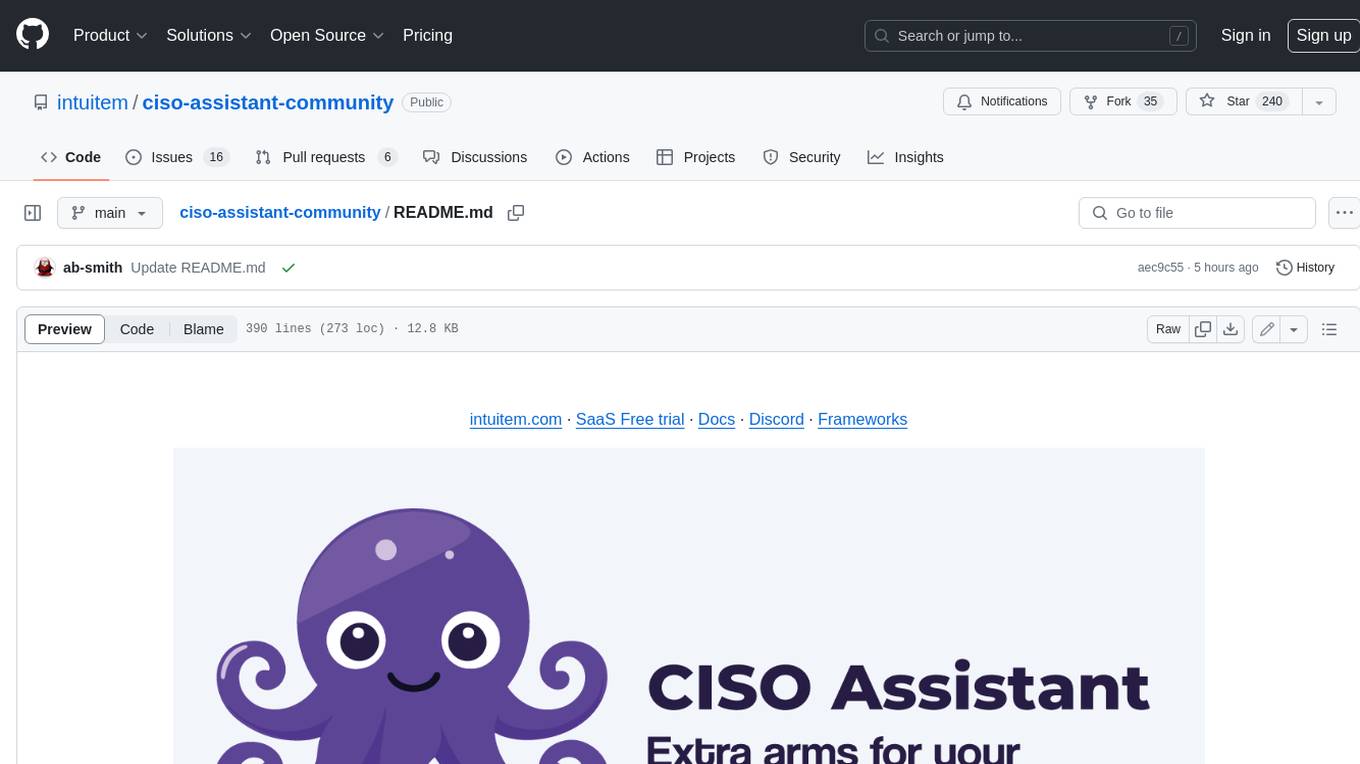
ciso-assistant-community
CISO Assistant is a tool that helps organizations manage their cybersecurity posture and compliance. It provides a centralized platform for managing security controls, threats, and risks. CISO Assistant also includes a library of pre-built frameworks and tools to help organizations quickly and easily implement best practices.
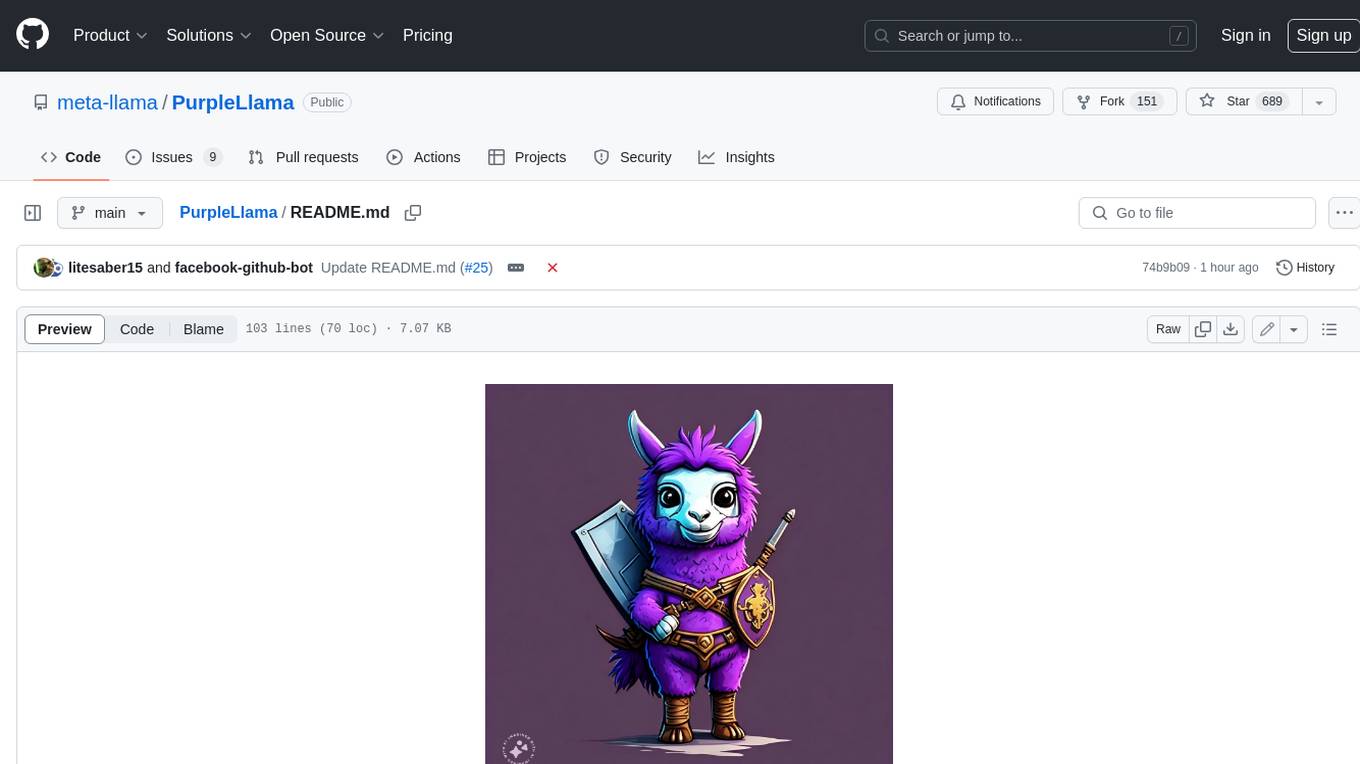
PurpleLlama
Purple Llama is an umbrella project that aims to provide tools and evaluations to support responsible development and usage of generative AI models. It encompasses components for cybersecurity and input/output safeguards, with plans to expand in the future. The project emphasizes a collaborative approach, borrowing the concept of purple teaming from cybersecurity, to address potential risks and challenges posed by generative AI. Components within Purple Llama are licensed permissively to foster community collaboration and standardize the development of trust and safety tools for generative AI.
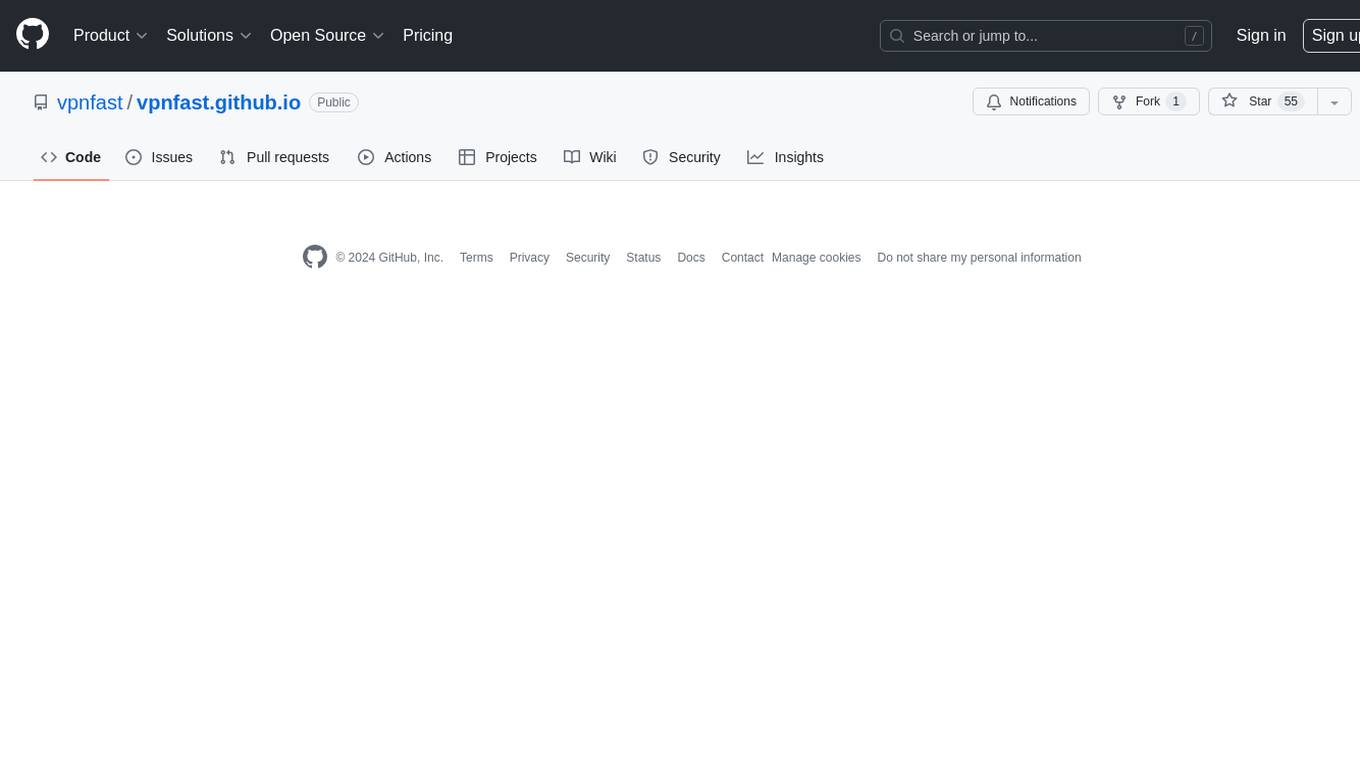
vpnfast.github.io
VPNFast is a lightweight and fast VPN service provider that offers secure and private internet access. With VPNFast, users can protect their online privacy, bypass geo-restrictions, and secure their internet connection from hackers and snoopers. The service provides high-speed servers in multiple locations worldwide, ensuring a reliable and seamless VPN experience for users. VPNFast is easy to use, with a user-friendly interface and simple setup process. Whether you're browsing the web, streaming content, or accessing sensitive information, VPNFast helps you stay safe and anonymous online.
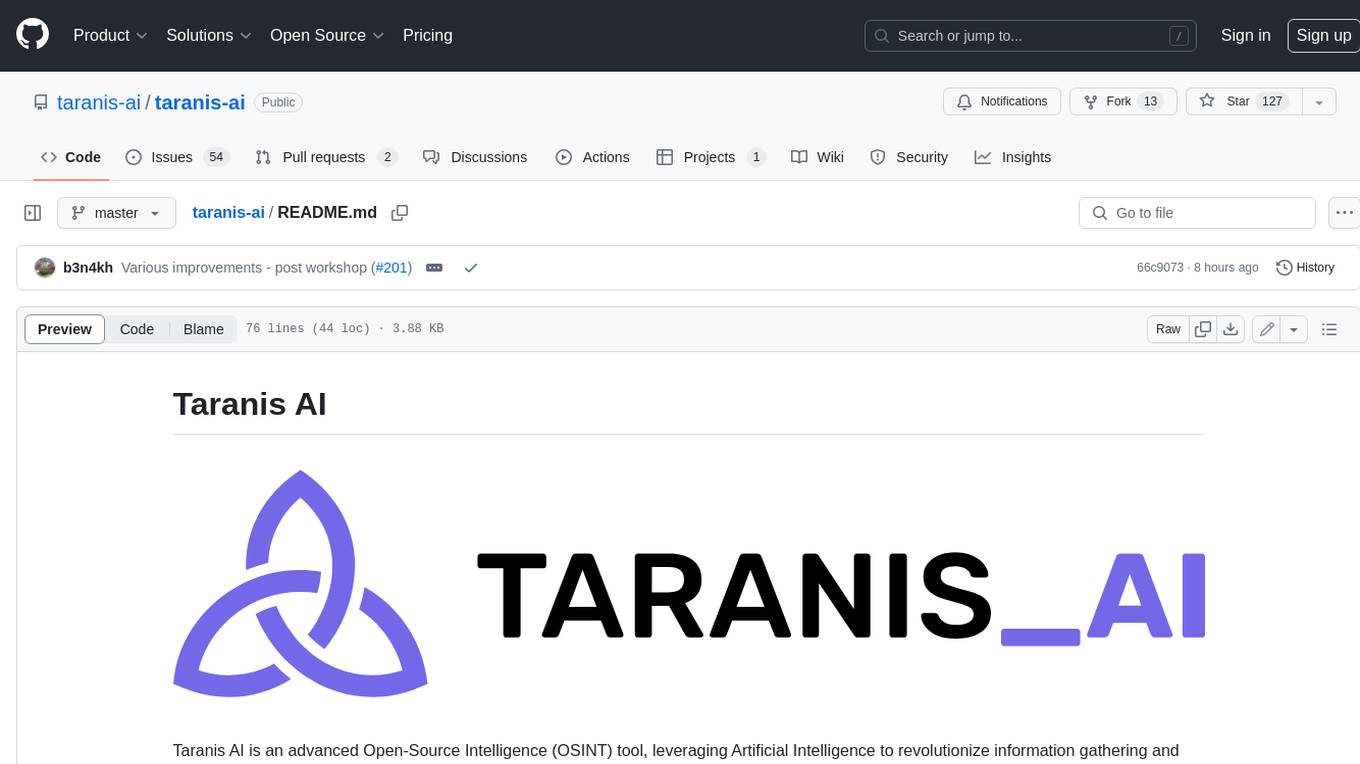
taranis-ai
Taranis AI is an advanced Open-Source Intelligence (OSINT) tool that leverages Artificial Intelligence to revolutionize information gathering and situational analysis. It navigates through diverse data sources like websites to collect unstructured news articles, utilizing Natural Language Processing and Artificial Intelligence to enhance content quality. Analysts then refine these AI-augmented articles into structured reports that serve as the foundation for deliverables such as PDF files, which are ultimately published.
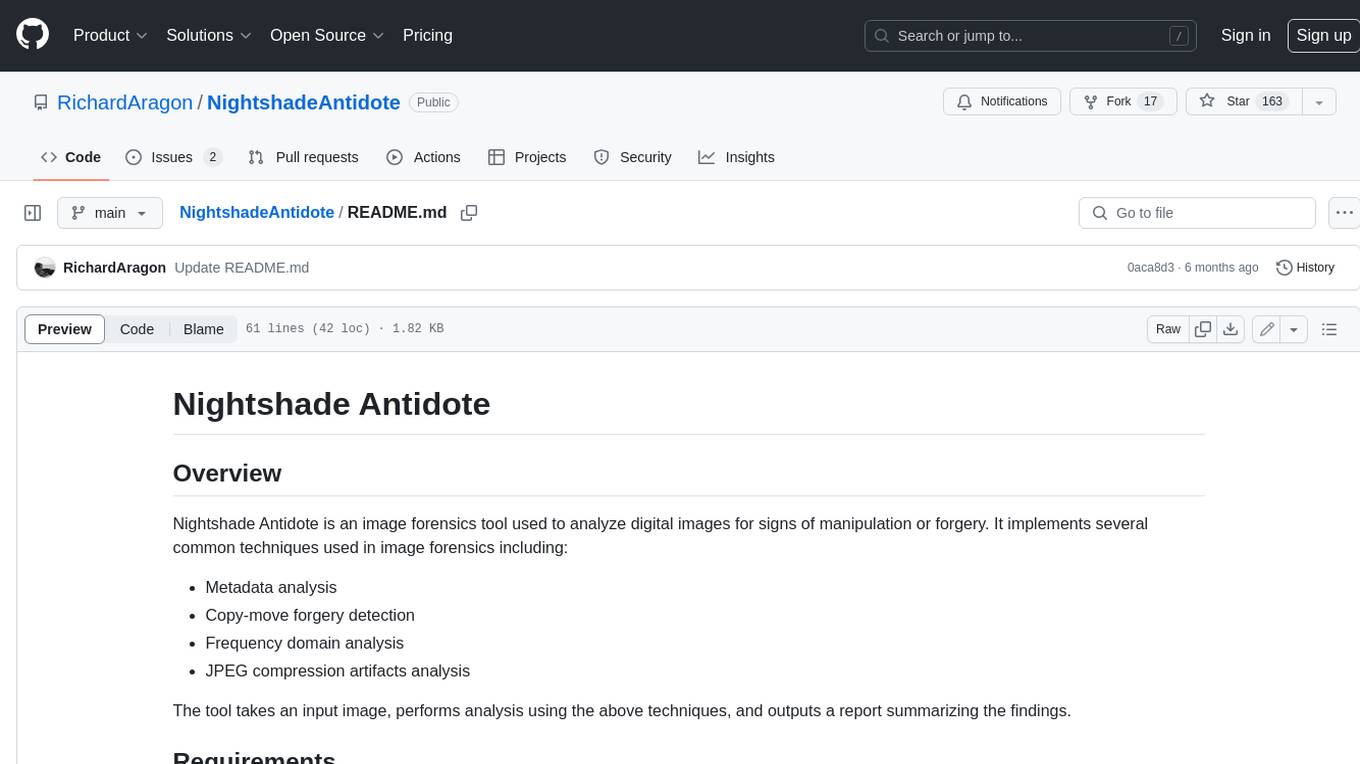
NightshadeAntidote
Nightshade Antidote is an image forensics tool used to analyze digital images for signs of manipulation or forgery. It implements several common techniques used in image forensics including metadata analysis, copy-move forgery detection, frequency domain analysis, and JPEG compression artifacts analysis. The tool takes an input image, performs analysis using the above techniques, and outputs a report summarizing the findings.
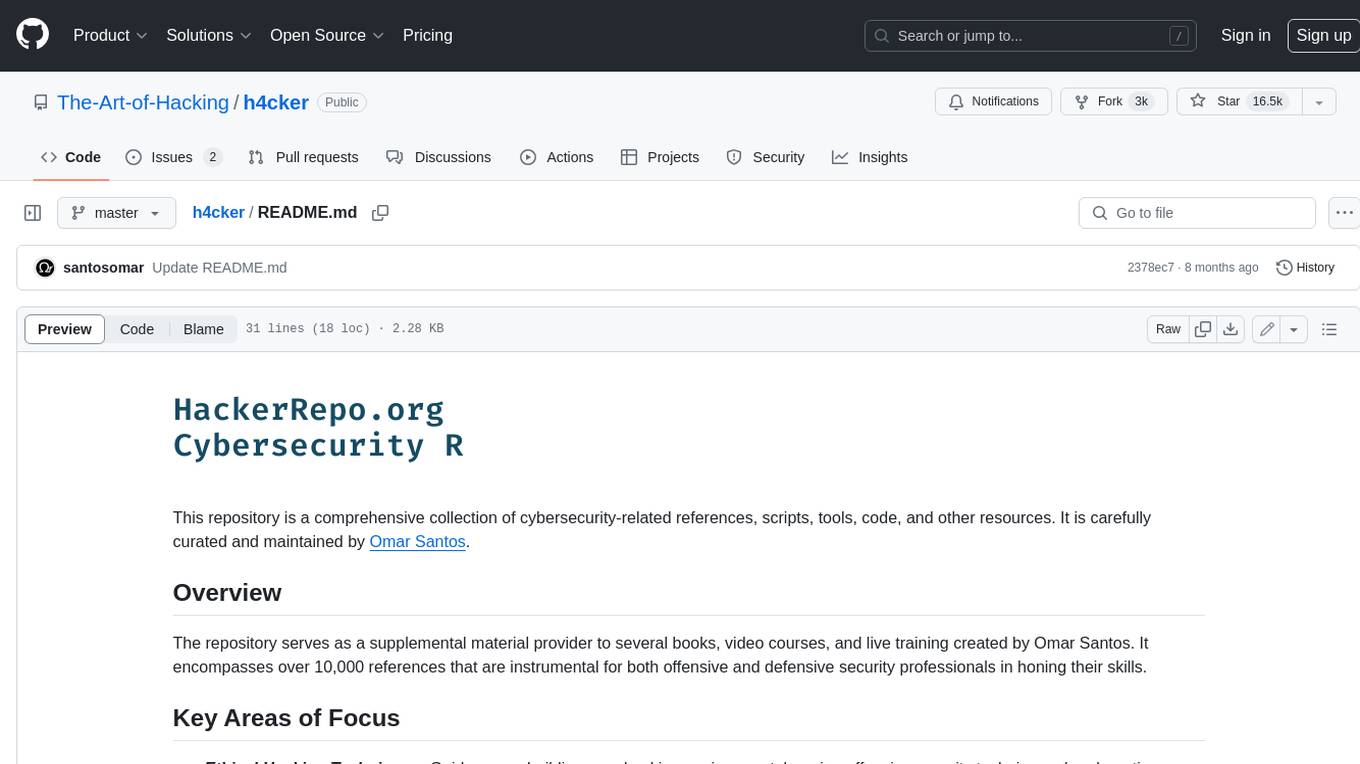
h4cker
This repository is a comprehensive collection of cybersecurity-related references, scripts, tools, code, and other resources. It is carefully curated and maintained by Omar Santos. The repository serves as a supplemental material provider to several books, video courses, and live training created by Omar Santos. It encompasses over 10,000 references that are instrumental for both offensive and defensive security professionals in honing their skills.
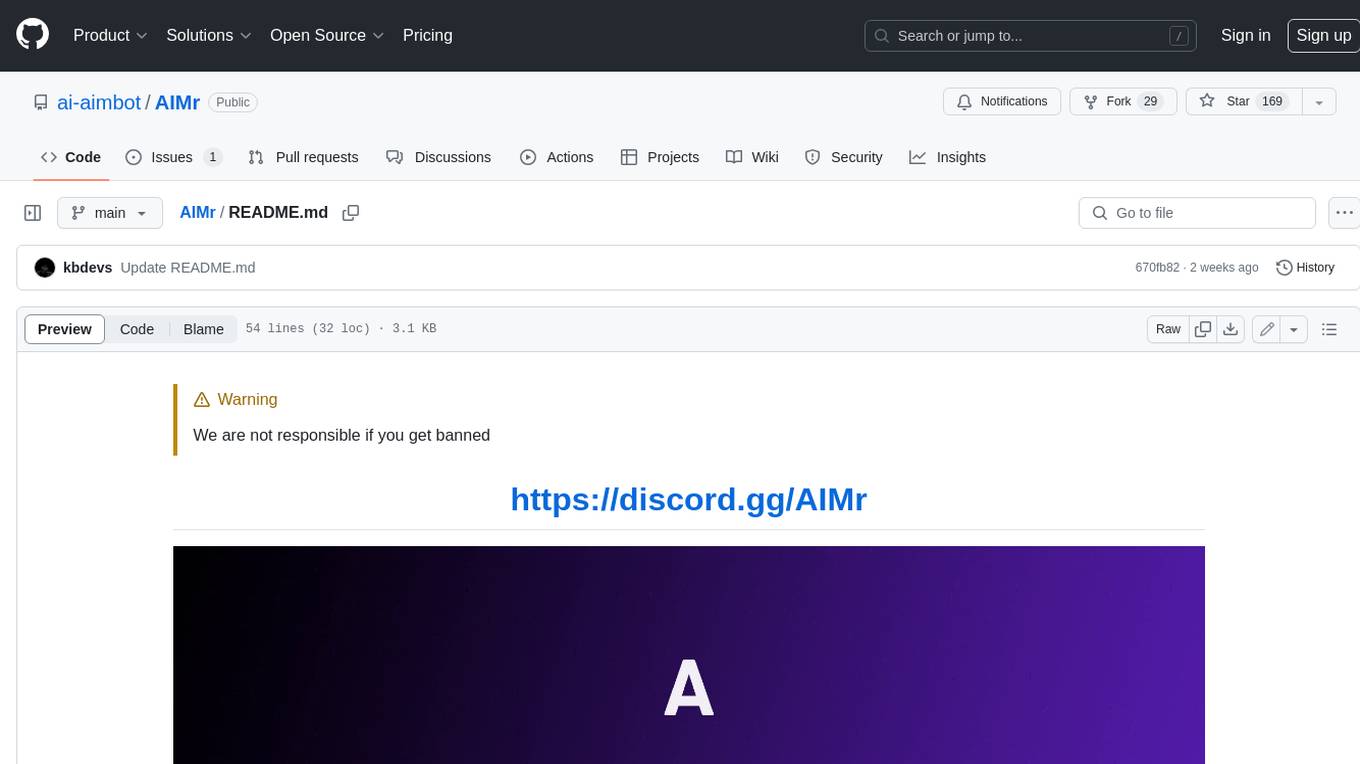
AIMr
AIMr is an AI aimbot tool written in Python that leverages modern technologies to achieve an undetected system with a pleasing appearance. It works on any game that uses human-shaped models. To optimize its performance, users should build OpenCV with CUDA. For Valorant, additional perks in the Discord and an Arduino Leonardo R3 are required.